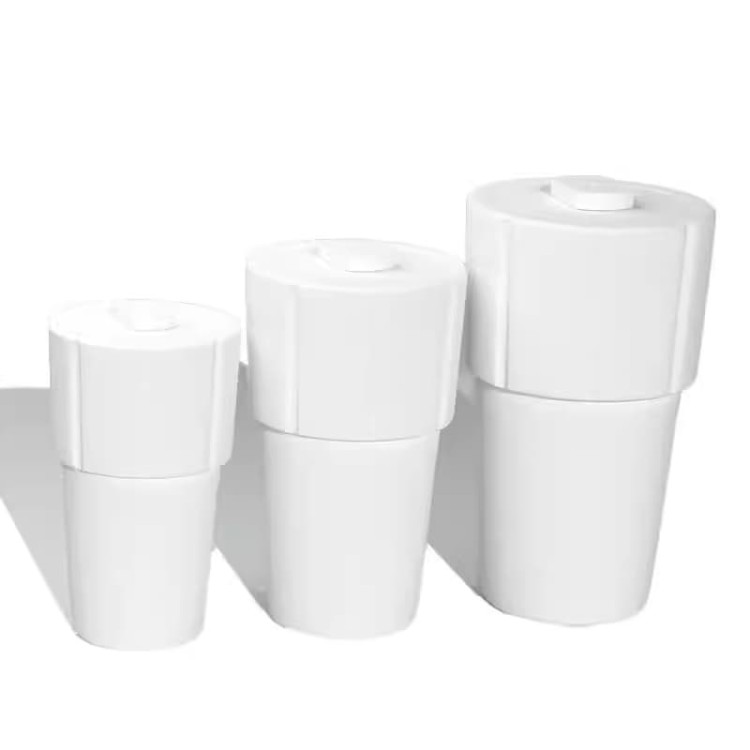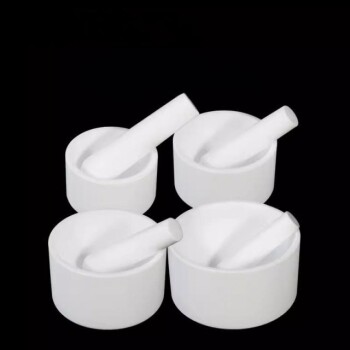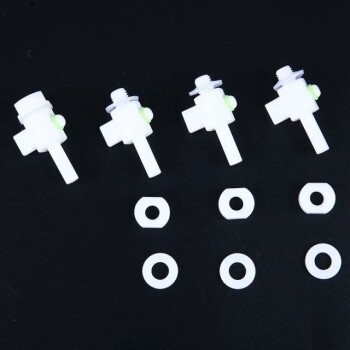
PTFE material
Custom PTFE Teflon Parts Manufacturer for Microwave Digestion Tank
Item Number : PTFE-37
Price varies based on specs and customizations
- Material
- PTFE
- Specification
- See the form
Shipping:
Contact us to get shipping details Enjoy On-time Dispatch Guarantee.
Why Choose Us
Reliable PartnerEasy ordering process, quality products, and dedicated support for your business success.
Introduction
PTFE digestion tanks are integral components in laboratory settings, particularly in applications involving harsh chemical environments and high temperatures. Here are the key features of PTFE digestion tanks, focusing on their benefits to the user:
- High-Temperature Resistance: PTFE digestion tanks can operate in temperatures ranging from -200°C to +250°C, making them suitable for a wide range of thermal processes.
- Exceptional Corrosion Resistance: With the ability to resist strong acids, strong alkalis, aqua regia, and various organic solvents, PTFE digestion tanks are ideal for use in environments where chemical resistance is crucial.
- Low Coefficient of Friction: PTFE's inherent low friction coefficient reduces wear and tear on the tank surfaces, enhancing the longevity of the equipment.
Details & Parts








Technical specifications
| Model | Diameter(mm) | Height(mm) |
|---|---|---|
| 30ml | 49.5 | 109 |
| 50ml | 55 | 114 |
| 100ml | 65 | 124 |
| 200ml | 74.5 | 143 |
Please consult for other sizes, customization is accepted.
Advantages
- Chemical Resistance: PTFE digestion tanks are highly resistant to both acids and alkalis, as well as various organic solvents, making them ideal for handling highly corrosive materials in laboratory settings.
- Temperature Tolerance: With a high working temperature range up to 260ºC, PTFE tanks can withstand extreme heat, ensuring stability and safety during high-temperature experiments.
- Non-Reactivity: PTFE is a super stable material that does not react chemically with any substances, ensuring that it will not contaminate or alter the chemical composition of the samples being processed.
- Low Friction Coefficient: The low friction coefficient of PTFE makes it an excellent anti-friction material, reducing wear and tear and enhancing the longevity of the equipment.
Designed for You
KinTek provide deep custom made service and equipment to worldwide customers, our specialized teamwork and rich experienced engineers are capable to undertake the custom tailoring hardware and software equipment requirements, and help our customer to build up the exclusive and personalized equipment and solution!
Would you please drop your ideas to us, our engineers are ready for you now!
FAQ
What Are The Advantages Of Using PTFE In The Hydrogen Energy Industry?
Can PTFE Be Modified For Specific Applications?
What Are The Benefits Of Using PTFE Petri Dish Liners?
4.7
out of
5
Unmatched durability and chemical resistance. A game-changer in lab efficiency!
4.8
out of
5
Optically clear and easy to clean. Perfect for detailed observations.
4.9
out of
5
High-temperature tolerance is impressive. No issues even under extreme heat.
4.7
out of
5
Lightweight yet robust. Ideal for frequent use in harsh environments.
4.8
out of
5
Chemical inertness ensures no sample contamination. Highly reliable.
4.9
out of
5
Flame retardant and safe. Adds peace of mind in the lab.
4.7
out of
5
Versatile and adaptable. Fits perfectly in our diverse lab needs.
4.8
out of
5
Low friction surface extends equipment life. Great investment.
4.9
out of
5
Easy to sterilize, crucial for preventing cross-contamination.
4.7
out of
5
Excellent value for money. Quality exceeds expectations.
4.8
out of
5
Speedy delivery and well-packaged. No damage on arrival.
4.9
out of
5
Technologically advanced. Enhances our lab's capabilities significantly.
4.7
out of
5
Durable and safe. A must-have for any serious lab.
REQUEST A QUOTE
Our professional team will reply to you within one business day. Please feel free to contact us!
Related Products

Custom PTFE Teflon Parts Manufacturer for PTFE Containers
PTFE container is a container with excellent corrosion resistance and chemical inertness.

Custom PTFE Teflon Parts Manufacturer for PTFE Measuring Cylinder 10/50/100ml
PTFE measuring cylinder are a rugged alternative to traditional glass cylinders. They are chemically inert over a wide temperature range (up to 260º C), have excellent corrosion resistance and maintain a low coefficient of friction, ensuring ease of use and cleaning.

Custom PTFE Teflon Parts Manufacturer for Gaskets and More
Gaskets are materials placed between two flat surfaces to enhance the seal. To prevent fluid leakage, sealing elements are arranged between static sealing surfaces.

Custom PTFE Teflon Parts Manufacturer PTFE Beaker and Lids
The PTFE beaker is a laboratory container that is resistant to acid, alkali, high and low temperatures and is suitable for temperatures ranging from -200ºC to +250ºC. This beaker has excellent chemical stability and is widely used for heat treatment samples and volume analysis.

Custom PTFE Teflon Parts Manufacturer for Cleaning Racks
PTFE cleaning racks are mainly made of tetrafluoroethylene. PTFE, known as the "King of Plastics", is a polymer compound made of tetrafluoroethylene.

Custom PTFE Teflon Parts Manufacturer for PTFE Tweezers
PTFE tweezers inherit the excellent physical and chemical properties of PTFE, such as high temperature resistance, cold resistance, acid and alkali resistance, and corrosion resistance to most organic solvents.

Custom PTFE Teflon Parts Manufacturer F4 Conical Flask Triangular Flask 50 100 250ml
The PTFE triangular flask, also known as a Teflon reagent bottle, is a robust, chemical-resistant alternative to traditional glass bottles, suitable for handling both acids and alkalis. These bottles are unbreakable, lightweight, and feature a leak-proof screw cap, making them ideal for laboratory use.

Custom Machined and Molded PTFE Teflon Parts Manufacturer with PTFE Crucible and Lid
PTFE crucibles, made from pure Teflon, offer chemical inertness and resistance from -196°C to 280°C, ensuring compatibility with a wide range of temperatures and chemicals. These crucibles feature machine-finished surfaces for easy cleaning and prevention of contamination, making them ideal for precise laboratory applications.

Custom PTFE Teflon Parts Manufacturer for PTFE Ball Valve Seat
Seats and inserts are vital components in the valve industry. As a key component, polytetrafluoroethylene is usually selected as the raw material.

Custom PTFE Teflon Parts Manufacturer Laboratory High Temperature Mixing Paddle Mixer
The PTFE mixing paddle mixer is a versatile and robust tool designed for laboratory use, particularly in environments requiring high resistance to chemicals and extreme temperatures. Crafted from high-quality PTFE, this mixer boasts several key features that enhance its functionality and durability.

Custom PTFE Teflon Parts Manufacturer for Culture Dish and Evaporation Dish
The PTFE culture dish evaporating dish is a versatile laboratory tool known for its chemical resistance and high-temperature stability. PTFE, a fluoropolymer, offers exceptional non-stick properties and durability, making it ideal for various applications in research and industry, including filtration, pyrolysis, and membrane technology.

Custom PTFE Teflon Parts Manufacturer Grinding Bowl
PTFE is renowned for its exceptional chemical resistance, thermal stability, and low friction properties, making it a versatile material in various industries. The PTFE grinding bowl, specifically, finds applications where these properties are crucial.

Custom PTFE Teflon Parts Manufacturer for PTFE Buchner Funnel and Triangular Funnel
The PTFE funnel is a piece of laboratory equipment used primarily for filtration processes, particularly in the separation of solid and liquid phases in a mixture. This setup allows for efficient and rapid filtration, making it indispensable in various chemical and biological applications.

Custom PTFE Teflon Parts Manufacturer for Centrifuge Tubes
PTFE centrifugal tubes are highly valued for their exceptional chemical resistance, thermal stability, and non-stick properties, making them indispensable in various high-demand sectors. These tubes are particularly useful in environments where exposure to corrosive substances, high temperatures, or stringent cleanliness requirements are prevalent.

Custom PTFE Teflon Parts Manufacturer for Air Valve Applications
PTFE small air valve for gas-liquid sampling and sampling bag for sample collection.

Custom PTFE Teflon Parts Manufacturer for Three-Necked Round Bottom Flask
PTFE flask, is a versatile laboratory container made from PTFE, offering exceptional chemical resistance, temperature stability, and non-stick properties. Ideal for handling corrosive substances and high-temperature applications, these flasks are essential in various laboratory procedures, including heating, mixing, and storage of chemicals.

Custom PTFE Teflon Parts Manufacturer for Centrifuge Tube Racks
The precision-made PTFE test tube racks are completely inert and, due to the high temperature properties of PTFE, these test tube racks can be sterilized (autoclaved) without any problems.

PTFE cleaning racks are mainly made of tetrafluoroethylene. PTFE, known as the "King of Plastics", is a polymer compound made of tetrafluoroethylene.

Custom PTFE Teflon Parts Manufacturer for PTFE Stirring Bar Recovery Rod
This product is used for stirrer recovery, and is resistant to high temperature, corrosion, and strong alkali, and is almost insoluble in all solvents. The product has a stainless steel rod inside and a polytetrafluoroethylene sleeve outside.
Related Articles

Exploring the Multifunctional Electrolytic Cell Water Bath: Applications and Benefits
Discover the versatile applications of multifunctional electrolytic cell water baths in various industries. Learn about their benefits, components, and how they facilitate chemical reactions and temperature control.

Manual Hydraulic Presses for Laboratory Use: A Comprehensive Guide
Explore the intricacies of manual hydraulic presses in labs, including operation, benefits, and comparison with automatic models. Ideal for those seeking detailed insights on sample preparation and cost-effectiveness.

Laboratory Sample Preparation and Digestion Equipment
Overview of essential lab equipment for sample preparation and digestion.

PTFE gasket: an all-around solution for flange sealing
Polytetrafluoroethylene (PTFE) gaskets have become an ideal choice in the field of flange sealing due to their unique chemical stability and high temperature resistance.